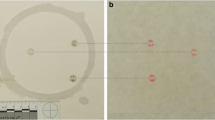Abstract
In this study, we applied a microscopic quantitative method based on the use of sodium rhodizonate to verify the presence of residues and their distribution on the cutis of gunshot wounds. A total of 250 skin samples were selected from cases in which the manner of death (accidental, suicide, and homicide) and the shooting distance could be reliably determined. The samples were examined under a light microscope, in transmitted bright field illumination and phase contrast mode, and with confocal laser scanning microscopy. In all skin specimens the area of each histological section was directly measured by an image analysis system. Both the number and the size of powder particles were measured. The distribution of gunshot residues (GSR) in the epidermal and subepidermal layers was also analyzed. The evaluation of the microscopic entrance wounds demonstrated different findings related to the range of fire. The data derived from the evaluation of both macroscopic and microscopic features demonstrated that the amount and the spatial distribution of GSR deposits in the skin surrounding entrance wounds strictly correlate with shooting distance.






Similar content being viewed by others
References
Stahling S, Karlsson T (2000) A method for collection of gunshot residues from skin and other surfaces. J Forensic Sci 45:1299–1302
Karger B, Puskas Z, Ruwald B, Teige K, Schuirer G (1998) Morphological findings in the brain after experimental gunshots using radiology, pathology and histology. Int J Legal Med 111:314–319
Große Perdekamp M, Vennemann B, Mattern D, Serr A, Pollak S (2005) Tissue defect at the gunshot entrance wound: what happens to the skin? Int J Legal Med 119:217–222
Faller-Marquardt M, Pollak S (2002) Skin tears away from the entrance wound in gunshots to the head. Int J Legal Med 116:262–266
Biedermann A, Taroni F (2006) A probabilistic approach to the joint evaluation of firearm evidence and gunshot residues. Forensic Sci Int. DOI 10.1016/j.forsciint.2005.11.001
Matty W (1987) Primer composition and gunshot residue. Assoc Firearms Tool Mark Exam J 19:8–13
Bydal BA (1990) Percussion primer mixes. Assoc Firearms Tool Mark Exam J 22:1–26
Wallace JS (1990) Chemical aspects of firearms ammunition. Assoc Firearms Tool Mark Exam J 22:364–389
Harrison HC, Gilroy R (1959) Firearm’s discharge residues. J Forensic Sci 4:184–199
Basu S (1982) Formation of gunshot residues. J Forensic Sci 27:72–91
Kage S, Kudo K, Kaizoji A, Ryumoto J, Ikeda H, Ikeda N (2001) A simple method for detection of gunshot residue particles from hands, hair, face, and clothing using scanning electron microscopy/wavelength dispersive X-ray (SEM/WDX). J Forensic Sci 46:830–834
Romolo FS, Margot P (2001) Identification of gunshot residue: a critical review. Forensic Sci Int 119:195–211
Lebiedzik J, Johnson DL (2000) Rapid search and quantitative analysis of gunshot residue particle in the SEM. J Forensic Sci 45:83–92
Marty W, Sigrist T, Wyler D (2002) Determination of firing distance using the rhodizonate staining technique. Int J Legal Med 116:1–4
Masters BR, So PTC (2001) Confocal microscopy and multi-photon excitation microscopy of human skin in vivo. Opt Exp 8:2–10
Adeyi O, Duval JV, Dupre ME, Andrew TA (2005) Role of chemical tests and scene investigation in determination of range of fire. Am J Forensic Med Pathol 26:166–169
Karger B, Hoekstra A, Schmidt PF (2001) Trajectory reconstruction from trace evidence on spent bullets. I. Deposits from intermediate targets. Int J Legal Med 115:16–22
Janssen W (1984) Forensic histopathology. Springer, Berlin Heidelberg New York, pp 289–292
Faller-Marquardt M, Bohnert M, Pollak S (2004) Detachment of the periosteum and soot staining of its underside in contact shots to the cerebral cranium. Int J Legal Med 118:343–347
Borlinghaus R, Gröbler B (1997) Basic principles and applications of confocal laser scanning microscopy. In: Isenberg G (ed) Modern optics, electronics, and high precision techniques in cell biology. Springer, Berlin Heidelberg New York, pp 35–53
Karger B, Billeb E, Koops E, Brinkmann B (2002) Autopsy features relevant for discrimination between suicidal and homicidal gunshot injuries. Int J Legal Med 116:273–278
Verhoff MA, Karger B (2003) Atypical gunshot entrance wound and extensive backspatter. Int J Legal Med 117:229–231
Plattner T, Kneubuehl B, Thali M, Zollinger U (2003) Gunshot residue patterns on skin in angled contact and near contact gunshot wounds. Forensic Sci Int 138:68–74
Williams R, Sellier K (1991) Shot range determination. Forensic science progress, vol. 6. Springer, Berlin Heidelberg New York, pp 1–104
Francisco JT (1980) Histopathology of gunshot wounds in microscopic diagnosis. In: Perper JA, Wecht CH (eds) Microscopic diagnosis in forensic pathology. CC Thomas, Springfield, Illinois, pp 327–336
Author information
Authors and Affiliations
Corresponding author
Rights and permissions
About this article
Cite this article
Neri, M., Turillazzi, E., Riezzo, I. et al. The determination of firing distance applying a microscopic quantitative method and confocal laser scanning microscopy for detection of gunshot residue particles. Int J Legal Med 121, 287–292 (2007). https://doi.org/10.1007/s00414-006-0110-1
Received:
Accepted:
Published:
Issue Date:
DOI: https://doi.org/10.1007/s00414-006-0110-1




